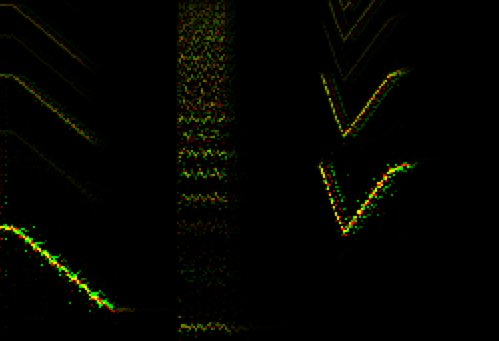Inflection: You are Only as Expressive as Your Control Voltages!
Welcome to my third post. I continue to expand on concepts from my first and second posts, so you may want to take a moment and check those out.
Inflection is defined as:
1) the act or result of curving or bending
2) change in pitch or loudness of the voice.
In spoken languages these changes or modulations in pitch, loudness and timbre convey meaning to the listener. Here is the utterance “ahh” with three different inflections:
1) is a sigh, relaxing 2) a warning and tense 3) a question
Each invokes its own expression and “feeling”. Even a sonogram of these sounds carries a visual resonance of their expression and impact:
1) a sigh 2) a warning 3) a query
And here are the 281e settings for similar effects of those CVs:
Use “pause” to freeze frame and study the 281e settings. From 00:00 to 00:01 is the “sigh” shape. From 00:02 to 00:07 I show how I took the first setting and ramped up the speed into the audio range to get the “warning” type sound which is then “triggered” at 00:08 to 00:09. Finally, 00:09 to the end is the “query” shape using the 256e to attenuate the 281e.
As you explore your own personal creative voice in the Buchlidian realm I suggest that you begin to collect sonic gestures that mean something to you. These gestures can sometimes be translated into control voltages that shape, mold, and modulate a sound. Remember, audio sounds are carried in tinijax cables and control voltages are connected via banana cables.
The 3 main “inflectors” or CV generators in the Buchla system are the 281e, the CV out of the 259e/261e and the Envelope Detectors (more on this module later).
Let’s quickly look at the above three sounds/sonograms in a very, very simple and rudimentary way by curving and bending a sound. Here I’ve just used three different CVs to approximate the three different “ahs”.
And, for comparison with the vocal “ahs”, here is a sonogram of the above CVs:
Now let’s hear what happens if I take that exact CV shape and change the pitch of the audio signal and repeat, stretch and change the timeframe of that cv and maybe also apply it to timbre:
Now let’s do that with the other two:
A warning variations
A query variations
Simple permutations resulting it dramatic possibilities!
Remember that you can create very complex and nuanced CV shapes with the 281e especially in Quadrature mode and OR’S mode. If you’d like more information on these checkout my Buchla Break No. 5 and Ron Millar’s youtube video.
Looking back in Buchla history you can hear a simple yet very effective use of a CV inflection subtly modulating a single tone near the beginning of Part A of Morton Subotnick’s Silver Apples of the Moon (1967):
And a more humorous example of inflection from Star Wars (1977):
And one of the most moving acoustical vocal examples of inflection, for me, is Asha Bhosle’s vocal at the beginning and end of the track The Way You Dream, from 1 Giant Leap – the subtle inflections are breath-taking:
Another interesting inflected “language” is that of birds and whales.
If you are interested in inflectional patterns that might spark CV explorations I suggest you checkout this cool birding site that has both audio and sonogram examples, a treasure trove of sonic ideas.
Also, back in the days when I was doing tape music, I discovered that taking a rough recording of a bird outside my window and slowing it down 4 octaves suggested a whale and vice versa:
Talk about expression from inflection!!
In closing, complex CVs have been a hallmark of the Buchla systems from the beginning. Morton Subotnick pioneered this approach and often used the 170 Mic PreAmp in conjunction with the 130 Envelope Detector.
The beauty of the Envelope Detector is that you can translate very subtle and complex vocal inflections into useable control voltages. Or, as Adam Scramstad (djangosfire) pointed out you can feed white noise into an Envelope Follower for some very interesting results:
Chronologically, here are the various types of Envelope Detectors Don Buchla has designed over the years:
170 Mic PreAmp + 130 Envelope Detector (1960s)
208 PreAmp & Envelope Detector (early 1970s)
230 Triple Envelope Follower (mid 1970s)
227e Mike PreAmp + Envelope Out (early 2000s)
207e PreAmp + Envelope Detector (2000s)
230e Triple Envelope Tracker (2000s)
When a voice, violin, guitar or any acoustical instrument slurs from one note to another there is a very subtle pitch artifact which is not present in a pure synthesized tone, the best way to give life, feeling and inflection to synthesized sounds is with subtle control voltages.
You are only as Expressive as Your Control Voltages
Easel Expedition ii
This expedition explores using the entire Easel keyboard as a voltage fader to control pitch, modulation, volume, et al. Here’s the video…
And here is the basic patch:
Keyboard as voltage fader
You can download a printable version of this patch here.


